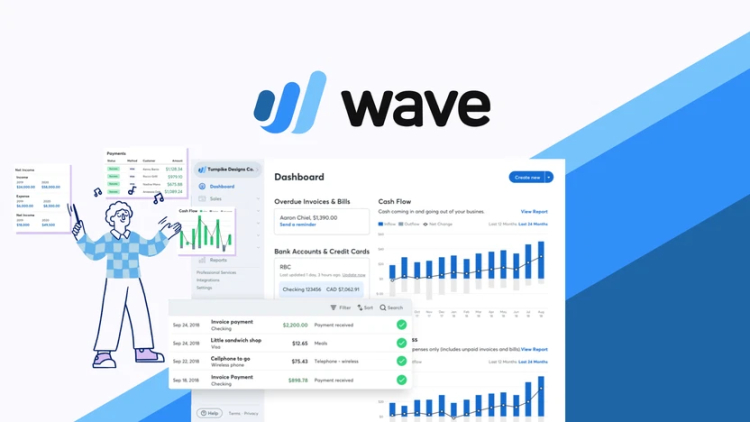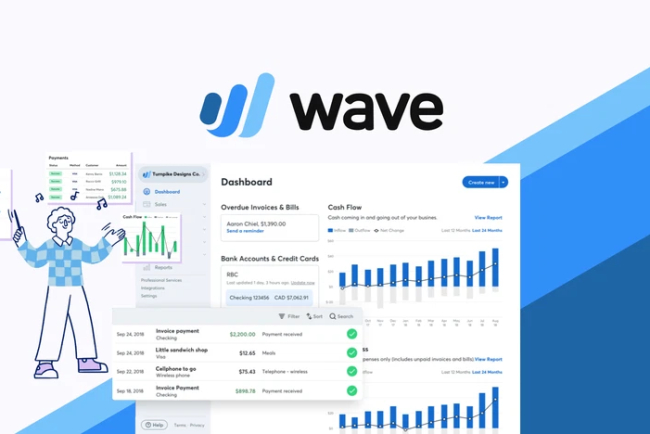Do I need to create a separate Wave account using my client’s email to manage their accounting?
Freelancers and virtual bookkeepers often wonder if they need to create separate Wave Accounting accounts using each client’s email. The answer? No. Wave allows you to manage multiple clients under a single login using separate business profiles. This blog explains how Wave's profile system works, how to manage client accounts without their emails, and when you might choose to use their email instead. Whether you handle 3 clients or 30, this guide helps streamline your workflow inside one Wave account. Do freelancers need a separate Wave account for every client? Learn how to manage multiple clients in Wave using one login with business profiles — no client email needed.

Do I Need to Create a Separate Wave Account Using My Client’s Email to Manage Their Accounting?
Introduction
If you're a freelance bookkeeper, accountant, or virtual assistant handling finances for multiple clients, you might wonder:
Should I create a separate Wave Accounting account for each client using their email address?
This is a common question, especially for beginners transitioning from tools like Tally, Excel sheets, or desktop-based accounting software. You may be thinking that managing each client’s financials might require logging into a unique account tied to their email — but the good news is:
You do not need to create separate Wave accounts for each client.
Instead, Wave Accounting allows you to manage multiple clients using one single login, keeping their financial data completely separate through a feature called “business profiles.” This system is powerful, efficient, and designed with service providers like you in mind.
In this blog post, you’ll learn exactly how this works, the pros and cons of both approaches, and when (if ever) using a client’s email might be helpful.
Understanding How Wave Works for Multiple Clients
Wave Accounting is built around business profiles — these act as independent accounting environments within a single Wave account.
Each business profile has its own:
-
Dashboard
-
Income and expenses
-
Invoices
-
Bank connections
-
Customers and vendors
-
Chart of accounts
-
Tax settings
-
Financial reports
-
Users and permissions
These profiles are fully separated. Managing them through one master Wave login gives you the ability to handle several clients without overlapping data, risking errors, or requiring client email addresses.
Why You Don’t Need to Use Your Client’s Email
Many freelancers mistakenly think they must:
-
Create a Wave account with the client’s email
-
Request verification through the client’s inbox
-
Log in separately to manage their books
This is unnecessary and can actually complicate your workflow. Here’s why:
-
Wave allows multiple business profiles under one login
-
Each business profile is independent, like separate companies in Tally or QuickBooks
-
You have full control to manage transactions, invoices, and reports
-
You can choose to grant client access later, if needed — without switching logins
So instead of handling five logins for five clients, you only need one Wave account tied to your own email.
Benefits of Using One Wave Account for All Clients
Here are the key advantages of managing multiple clients without needing their emails:
1. Simplicity
Log in once, manage everything. No password lists, browser conflicts, or switching between accounts.
2. Full Control
You manage all transactions, reporting, and settings. Clients are not burdened with setup or tech questions.
3. Isolated Workspaces
Each client’s business profile is cleanly separated. No risk of mixing reports or transactions.
4. Easy Report Sharing
Download Profit & Loss, Balance Sheet, and other reports as PDFs or CSVs. Email them to your clients directly.
5. Optional Client Access
If clients ever want to view or manage their finances, you can invite them to their specific business profile without giving access to others.
Step-by-Step: Managing a Client’s Accounting Without Using Their Email
Let’s walk through the practical steps.
Step 1: Log Into Your Wave Account
Go to waveapps.com and log in using your own email address.
Step 2: Create a New Business Profile
Click your current business name (top-left corner), then click “Create a new business.”
Fill in the client’s details:
-
Business name
-
Industry
-
Type of business
-
Country and currency
-
Fiscal year start
Click Save. You are now inside that client’s dedicated business profile.
Step 3: Add Their Transactions
You can now start:
-
Entering income and expenses
-
Uploading receipts
-
Creating invoices
-
Connecting their bank account (with permission)
-
Categorizing transactions
-
Generating and downloading reports
All of this is done without needing your client’s email or login credentials.
When Might You Want to Use Your Client’s Email?
Although it’s not necessary, there are a few cases where using your client’s email — or giving them access to their Wave profile — might be helpful:
Scenario 1: The Client Wants Full Control
If the client prefers to manage their own finances and just needs occasional help, they may want to open a Wave account themselves.
In this case:
-
They create the Wave account using their email
-
They invite you as a collaborator (Admin, Editor, or Viewer)
You’ll then log in using your email, access their profile only, and assist as needed.
Scenario 2: Team Collaboration
If your client has a team member (e.g., a finance officer or business manager) who also needs access, Wave allows multi-user access per business.
You can manage their books and invite them later using their email — without needing to open an account on their behalf.
Pros and Cons: One Login vs. Separate Accounts
Let’s compare the two approaches:
| Approach | Pros | Cons |
|---|---|---|
| One Wave Account (One Login) | Easy to manage; No login switching; Full control; Efficient report generation | Requires you to manage all client data |
| Separate Wave Accounts Using Client Emails | Gives client full control; Better if they want direct access | Time-consuming; Multiple logins; Difficult to switch; Verification delays |
Unless your client specifically requests to manage their own Wave account, the one-login, multi-profile approach is usually best.
Frequently Asked Questions
Q: Can I really manage multiple clients from one Wave login?
Yes. Each business profile is independent. You can add as many as needed (10–15 comfortably) under your one email.
Q: Can I accidentally mix data between clients?
No. Each profile is isolated. You must manually switch between businesses, so no overlap happens unless you make an error.
Q: Can I invite my client later if needed?
Yes. Within each business profile, go to Settings > Users > Add User, then assign Viewer, Editor, or Admin access using their email.
Q: Will clients see my other business profiles?
No. When you invite a user, they only see the specific profile you invited them to.
Q: Is there a limit to the number of business profiles I can create?
Wave doesn’t publish a strict limit, but users generally manage 10–15 businesses without issues.
Q: Can I give clients reports without giving them access?
Yes. You can generate and export reports as PDF or Excel, then send them via email or cloud drive.
Best Practices for Managing Clients Without Their Emails
-
Create Separate Profiles for Each Client
Use distinct names like “ABC Design (Client)” or “XYZ Stores” to stay organized. -
Double-Check You’re in the Right Profile
Before adding transactions, verify which business you’re in. -
Use a Naming Convention
Label invoices, folders, and reports with the client’s name for easy retrieval. -
Back Up Reports Monthly
Download reports monthly and store them in client folders. -
Maintain Clear Communication
Let clients know you’re managing their accounts in your system and provide reports on schedule.
Case Study: A Freelance Bookkeeper Managing Clients
Let’s say Priya is a freelance bookkeeper. She manages accounting for four clients:
-
A salon business
-
A freelance writer
-
A home bakery
-
An online clothing store
She creates four business profiles in her Wave account:
-
“Glow & Shine Salon”
-
“WriteSmart Freelancer”
-
“SweetBakes Kitchen”
-
“Trendy Threads Boutique”
She:
-
Tracks each client's income and expenses
-
Uploads scanned receipts
-
Sends invoices using each client’s branding
-
Prepares monthly reports (Profit & Loss, Balance Sheet)
-
Emails reports at the start of every month
She does all this without asking for any client emails or setting up separate accounts — just one login, four clean workspaces.
Conclusion
No — you do not need to create a separate Wave account using your client’s email to manage their accounting.
Wave is designed to support multiple business profiles under a single login, making it incredibly efficient for freelancers, accountants, and virtual bookkeepers managing multiple clients.
Instead of jumping between accounts or requesting email verification, you can create and manage each client’s accounting profile inside your Wave dashboard — keeping everything organized, secure, and professional.
If a client later wants access, simply invite them to their business profile. Until then, enjoy the simplicity and control of a single, centralized Wave account for all your clients’ accounting needs.
What's Your Reaction?





















